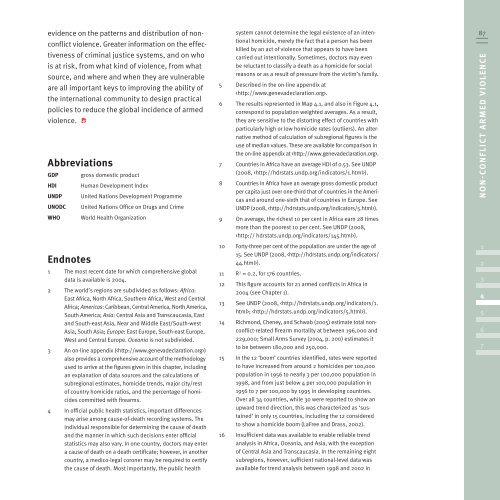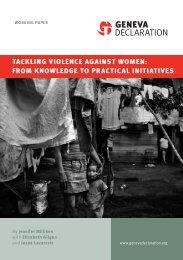Global Burden of Armed Violence - The Geneva Declaration on ...
Global Burden of Armed Violence - The Geneva Declaration on ...
Global Burden of Armed Violence - The Geneva Declaration on ...
You also want an ePaper? Increase the reach of your titles
YUMPU automatically turns print PDFs into web optimized ePapers that Google loves.
evidence <strong>on</strong> the patterns and distributi<strong>on</strong> <str<strong>on</strong>g>of</str<strong>on</strong>g> n<strong>on</strong>c<strong>on</strong>flict<br />
violence. Greater informati<strong>on</strong> <strong>on</strong> the effectiveness<br />
<str<strong>on</strong>g>of</str<strong>on</strong>g> criminal justice systems, and <strong>on</strong> who<br />
is at risk, from what kind <str<strong>on</strong>g>of</str<strong>on</strong>g> violence, from what<br />
source, and where and when they are vulnerable<br />
are all important keys to improving the ability <str<strong>on</strong>g>of</str<strong>on</strong>g><br />
the internati<strong>on</strong>al community to design practical<br />
policies to reduce the global incidence <str<strong>on</strong>g>of</str<strong>on</strong>g> armed<br />
violence.<br />
Abbreviati<strong>on</strong>s<br />
GDP gross domestic product<br />
HDI Human Development Index<br />
UNDP United Nati<strong>on</strong>s Development Programme<br />
UNODC United Nati<strong>on</strong>s Office <strong>on</strong> Drugs and Crime<br />
WHO World Health Organizati<strong>on</strong><br />
Endnotes<br />
1 <str<strong>on</strong>g>The</str<strong>on</strong>g> most recent date for which comprehensive global<br />
data is available is 2004.<br />
2 <str<strong>on</strong>g>The</str<strong>on</strong>g> world’s regi<strong>on</strong>s are subdivided as follows: Africa:<br />
East Africa, North Africa, Southern Africa, West and Central<br />
Africa; Americas: Caribbean, Central America, North America,<br />
South America; Asia: Central Asia and Transcaucasia, East<br />
and South-east Asia, Near and Middle East/South-west<br />
Asia, South Asia; Europe: East Europe, South-east Europe,<br />
West and Central Europe. Oceania is not subdivided.<br />
3 An <strong>on</strong>-line appendix ()<br />
also provides a comprehensive account <str<strong>on</strong>g>of</str<strong>on</strong>g> the methodology<br />
used to arrive at the figures given in this chapter, including<br />
an explanati<strong>on</strong> <str<strong>on</strong>g>of</str<strong>on</strong>g> data sources and the calculati<strong>on</strong>s <str<strong>on</strong>g>of</str<strong>on</strong>g><br />
subregi<strong>on</strong>al estimates, homicide trends, major city/rest<br />
<str<strong>on</strong>g>of</str<strong>on</strong>g> country homicide ratios, and the percentage <str<strong>on</strong>g>of</str<strong>on</strong>g> homicides<br />
committed with firearms.<br />
4 In <str<strong>on</strong>g>of</str<strong>on</strong>g>ficial public health statistics, important differences<br />
may arise am<strong>on</strong>g cause-<str<strong>on</strong>g>of</str<strong>on</strong>g>-death recording systems. <str<strong>on</strong>g>The</str<strong>on</strong>g><br />
individual resp<strong>on</strong>sible for determining the cause <str<strong>on</strong>g>of</str<strong>on</strong>g> death<br />
and the manner in which such decisi<strong>on</strong>s enter <str<strong>on</strong>g>of</str<strong>on</strong>g>ficial<br />
statistics may also vary. In <strong>on</strong>e country, doctors may enter<br />
a cause <str<strong>on</strong>g>of</str<strong>on</strong>g> death <strong>on</strong> a death certificate; however, in another<br />
country, a medico-legal cor<strong>on</strong>er may be required to certify<br />
the cause <str<strong>on</strong>g>of</str<strong>on</strong>g> death. Most importantly, the public health<br />
system cannot determine the legal existence <str<strong>on</strong>g>of</str<strong>on</strong>g> an intenti<strong>on</strong>al<br />
homicide, merely the fact that a pers<strong>on</strong> has been<br />
killed by an act <str<strong>on</strong>g>of</str<strong>on</strong>g> violence that appears to have been<br />
carried out intenti<strong>on</strong>ally. Sometimes, doctors may even<br />
be reluctant to classify a death as a homicide for social<br />
reas<strong>on</strong>s or as a result <str<strong>on</strong>g>of</str<strong>on</strong>g> pressure from the victim’s family.<br />
5 Described in the <strong>on</strong>-line appendix at<br />
.<br />
6 <str<strong>on</strong>g>The</str<strong>on</strong>g> results represented in Map 4.1, and also in Figure 4.1,<br />
corresp<strong>on</strong>d to populati<strong>on</strong> weighted averages. As a result,<br />
they are sensitive to the distorting effect <str<strong>on</strong>g>of</str<strong>on</strong>g> countries with<br />
particularly high or low homicide rates (outliers). An alternative<br />
method <str<strong>on</strong>g>of</str<strong>on</strong>g> calculati<strong>on</strong> <str<strong>on</strong>g>of</str<strong>on</strong>g> subregi<strong>on</strong>al figures is the<br />
use <str<strong>on</strong>g>of</str<strong>on</strong>g> median values. <str<strong>on</strong>g>The</str<strong>on</strong>g>se are available for comparis<strong>on</strong> in<br />
the <strong>on</strong>-line appendix at .<br />
7 Countries in Africa have an average HDI <str<strong>on</strong>g>of</str<strong>on</strong>g> 0.53. See UNDP<br />
(2008, ).<br />
8 Countries in Africa have an average gross domestic product<br />
per capita just over <strong>on</strong>e-third that <str<strong>on</strong>g>of</str<strong>on</strong>g> countries in the Americas<br />
and around <strong>on</strong>e-sixth that <str<strong>on</strong>g>of</str<strong>on</strong>g> countries in Europe. See<br />
UNDP (2008, ).<br />
9 On average, the richest 10 per cent in Africa earn 28 times<br />
more than the poorest 10 per cent. See UNDP (2008,<br />
).<br />
10 Forty-three per cent <str<strong>on</strong>g>of</str<strong>on</strong>g> the populati<strong>on</strong> are under the age <str<strong>on</strong>g>of</str<strong>on</strong>g><br />
15. See UNDP (2008, ).<br />
11 R 2 = 0.2, for 176 countries.<br />
12 This figure accounts for 21 armed c<strong>on</strong>flicts in Africa in<br />
2004 (see Chapter 1).<br />
13 See UNDP (2008, ; ).<br />
14 Richm<strong>on</strong>d, Cheney, and Schwab (2005) estimate total n<strong>on</strong>c<strong>on</strong>flict-related<br />
firearm mortality at between 196,000 and<br />
229,000; Small Arms Survey (2004, p. 200) estimates it<br />
to be between 180,000 and 250,000.<br />
15 In the 12 ‘boom’ countries identified, rates were reported<br />
to have increased from around 2 homicides per 100,000<br />
populati<strong>on</strong> in 1956 to nearly 3 per 100,000 populati<strong>on</strong> in<br />
1998, and from just below 4 per 100,000 populati<strong>on</strong> in<br />
1956 to 7 per 100,000 by 1995 in developing countries.<br />
Over all 34 countries, while 30 were reported to show an<br />
upward trend directi<strong>on</strong>, this was characterized as ‘sustained’<br />
in <strong>on</strong>ly 15 countries, including the 12 c<strong>on</strong>sidered<br />
to show a homicide boom (LaFree and Drass, 2002).<br />
16 Insufficient data was available to enable reliable trend<br />
analysis in Africa, Oceania, and Asia, with the excepti<strong>on</strong><br />
<str<strong>on</strong>g>of</str<strong>on</strong>g> Central Asia and Transcaucasia. In the remaining eight<br />
subregi<strong>on</strong>s, however, sufficient nati<strong>on</strong>al-level data was<br />
available for trend analysis between 1998 and 2002 in<br />
87<br />
NON- CO N F L I C T A R M E D V I O L E N C E<br />
1<br />
2<br />
3<br />
4<br />
5<br />
6<br />
7









